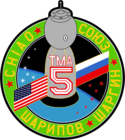Salischan Schakirowitsch Scharipow
| Salischan Scharipow | |
|---|---|
 | |
| Land | Russland |
| Organisation | Roskosmos |
| ausgewählt | 11. Mai 1990 |
| Einsätze | 2 Raumflüge |
| Start des ersten Raumflugs | 23. Januar 1998 |
| Landung des letzten Raumflugs | 24. April 2005 |
| Zeit im Weltraum | 201d 14h 50min |
| EVA-Einsätze | 2 |
| EVA-Gesamtdauer | 9h 58min |
| ausgeschieden | 18. Juli 2008 |
| Raumflüge | |
| |
Salischan Schakirowitsch Scharipow (russisch Салижан Шакирович Шарипов, wiss. Transliteration Saližan Šakirovič Šaripov; * 24. August 1964 in Ösgön, Oblast Osch, Kirgisische SSR, Sowjetunion) ist ein ehemaliger russischer Kosmonaut.
Scharipow besuchte in Charkiw die Höhere Militärfliegerschule „Sergei Gretsewets“, die er 1987 mit einem Diplom in taktischem Luftkampf abschloss. Anschließend war er als Pilotenausbilder tätig.
Er wurde im Mai 1990 in das sowjetische Kosmonautenprogram als Testkosmonaut aufgenommen und nahm an zwei Raumflügen teil:
- 23.–31. Januar 1998, als „mission specialist“ mit der STS-89
- 14. Oktober 2004 – 24. April 2005, als Bordingenieur mit der Sojus TMA-5 und der ISS-10
Von Oktober 2005 bis Mai 2006 diente Scharipov als Director of Operations der russischen Raumfahrtagentur beim Johnson Space Center in Houston. Am 18. Juli 2008 schied er aus dem Program aus.
Zusammen mit seiner Frau Nadeschda hat er zwei Kinder.
Weblinks
- Kurzbiografie von Salischan Schakirowitsch Scharipow bei spacefacts.de
- Biografie von Salischan Schakirowitsch Scharipow in der Encyclopedia Astronautica (englisch)
- Biografie von Salischan Schakirowitsch Scharipow beim Juri-Gagarin-Kosmonautentrainingszentrum (russisch)
| Personendaten | |
|---|---|
| NAME | Scharipow, Salischan Schakirowitsch |
| ALTERNATIVNAMEN | Шарипов, Салижан Шакирович (russisch) |
| KURZBESCHREIBUNG | russischer Kosmonaut |
| GEBURTSDATUM | 24. August 1964 |
| GEBURTSORT | Ösgön, Kirgisische SSR, Sowjetunion |
Auf dieser Seite verwendete Medien
* In the STS-89 crew insignia, the link between the United States and Russia is symbolically represented by the Space Shuttle Endeavour and Russia's Mir Space Station orbiting above the Bering Strait between Siberia and Alaska. The success of the joint United States-Russian missions is depicted by the Space Shuttle and Mir colored by the rising sun in the background.
- A shadowed representation of the International Space Station (ISS) rising with the sun represents the future program for which the Shuttle-Mir missions are prototypes. The inside rim of the insignia describes the outline of the number eight representing STS-89 as the eighth Shuttle/Mir docking mission.
- The nine stars represent the nine joint missions to be flown of the program and when combined with the number eight in the rim, reflect the mission number. The nine stars also symbolize the children of the crew members who will be the future beneficiaries of the joint development work of the space programs of the two countries.
- Along the rim are the crew members' names with David A. Wolf's name on the left and Andrew S. W. Thomas' name on the right, the returning and upgoing cosmonaut guest researcher crew members. In between and at the bottom is the name of Salizan S. Sharipov, payload specialist representing Russian Space Agency (RSA), in Cyrillic alphabet.
- The other crew members are Terrence W. Wilcutt, commander; Joe F. Edwards, Jr., pilot; and mission specialists Michael P. Anderson, Bonnie J. Dunbar, and James F. Reilly. The red, white and blue of the rim reflect the colors of the American and Russian flags which are also represented in the rim on either side of the joined spacecraft.
The Expedition 10 patch uses simple symbolism to describe the mission. The large Roman numeral "X," formed by the American and Russian flags, symbolizes the joint nature of this mission, as well as the fact that this flight is the 10th mission to stay on the International Space Station (ISS). The current configuration of the ISS is next to the name of the ISS Commander, while the Soyuz vehicle is placed next to the name of the Soyuz Commander. The single star and the black background signify this is a space mission.
This Soyuz TMA-5 patch was designed by Alex Panchenko:
"I've started design works of patches for Soyuz TMA-5 (ISS-10 flight) back in July 2004, when first sketches - drawings made in Starbucks coffee and later presented them for approval to Soyuz commander S. Sharipov. It was still not clear who is going to be third crew member of Soyuz and in this case I was preparing for Soyuz TMA-5 flight design in two variants (with name of Polonsky and with name of Shargin - both candidates on third seat in Soyuz).
During design work with Soyuz TMA-5 patch my idea was to present Soyuz panels as symbolic flags of Russia and United States, and base of design is a window view outside. Crew names are in the same order as their actual seats inside Soyuz. Commander S. Sharipov in center, L. Chiao on the left from commander and Y. Shargin on the right side."



